Service Function Chaining to Support Ultra-Low Latency Communication in NFV †
Abstract
:1. Introduction
- We propose a novel and efficient SFC embedding methodology that takes into account flow prioritization and physical resource reservation for high-priority flows;
- We formulate the SFC embedding problem as an integer linear programming (ILP) optimization model with the objective of minimizing latency and optimizing the allocation of physical network resources (bandwidth, CPU, and RAM memory);
- We propose a set of heuristic algorithms that achieve near-optimal solutions with a minimal optimality gap and execution time to solve the scalability issue for large-scale network topologies;
- A comprehensive analysis is conducted on the algorithms that are provided. Our proposed algorithms demonstrate improved performance in terms of lower end-to-end delay, enhanced bandwidth utilization, and an increased acceptance rate of ultra-low latency applications.
2. Related Work
3. System Model
3.1. Physical Network
3.2. Service Function Chain Request
4. Problem Formulation (ILP)
5. Heuristic Approach
5.1. Fast Application-Aware SFC (FAS) Embedding Algorithm
| Algorithm 1: FAS Algorithm |
| Input: = (,) ← Physical Network; , , |
| Output: ← Selected path for SFC request f; |
| 1: for each SFC request f do 2: = empty; 3: CN = Src (f) ← Set source of f as Current Node (CN); 4: Free Resources = Calculate_Free_Resources (Flow f) ← (bandwidth, CPU and memory); 5: Prune (, ← Pruning the CDC nodes and the links, which cannot be used to serve SFC request f; 6: for each VNF x in do 7: Find Nearest CDC Providing x (CN, x) ← Dijkstra; 8: CN = next CDC; 9: Update Used Resources; 10: Update SP; 11: end for 12: Find shortest path from CDC to the Des (flow) ← Dijkstra; 13: Update Used Resources; 14: Update SP; 15: end for 16: return SP; |
| Algorithm 2: Calculate_Free_Resources |
| Input: Flow f, |
| Output: Free Resources (Bandwidth, CPU and Memory); |
| 1: Calculate_Free_Resources (Flow f) 2: Free Resources= ( × Network Capacity)—Used Resources; 3: if Flow f has high-priority then 4: Free Resources= Free Resources + ((1 − ) × Network Capacity); 5: end if 6: if Free Resource < 0 then Free Resources= 0; ← Since (1 − )% is reserved for high priority, the Free Resources value for low-priority can become negative. 7: end if 8: return Free Resources; |
| Algorithm 3: Update Used Resources |
| Input: Route, Flow f, |
| Output: Used Resources (Bandwidth, CPU and Memory); |
| 1: Used Reources (Route, Flow f) 2: for each (node m → node n) in Route do 3: if Flow f has high-priority then 4: reduce Required Resources from ((1 − ) × Network Capacity); 5: if ((1 − ) × Network Capacity) < Required Resources 6: then reduce the remaining from ( × Network Capacity); 7: end if 8: else 9: reduce the Required Resources from ( × Network Capacity); 10: end if 11: end for 12: return Used Resources; |
5.2. Nearest-Service Function-First (NSF) Algorithm
| Algorithm 4: NSF Algorithm |
| Input: K, s, d, N Output: SP ← SP is the Selected Path; 1: for each flow f in F do 2: = empty; 3: CN = s ← CN is the current node; 4: for each VNF k in K do 5: [v, p] = Find_Nearest_Providers (CN, k, N); ← Dijkstra; 6: 7: CN = v; 8: , p); 9: end for 10: p = Shortest_Path (CN, d); ← Dijkstra; 11: 12: , p); 13: end for 14: return SP; |
5.3. Greedy Algorithm
| Algorithm 5: Greedy Algorithm |
| Input: ) ← Physical Network; Output: ← Selected Path for SFC request f; 1: for each SFC request f do 2: = empty; 3: CN = Src (f) ← Set source of f as Current Node (CN); 4: , ← Pruning the CDC nodes and the links, which cannot be used to serve SFC request f; 5: do 6: Find Nearest CDC Providing x (CN, x) ← Greedy; 7: CN = next CDC; 8: Update Used Resources; 9: Update SP; 10: end for 11: Find shortest path from CDC to the Des (flow) ← Greedy; 12: Update Used Resources; 13: Update SP; 14: end for 15: return SP; |
6. Results
6.1. Simulation Results Using Gridnet Network Topology
6.2. Simulation Results Using EliBackbone Network Topology
7. Conclusions
Author Contributions
Funding
Institutional Review Board Statement
Informed Consent Statement
Data Availability Statement
Conflicts of Interest
References
- Mulligan, U. Network Functions Virtualisation (NFV). Available online: https://www.etsi.org/technologies/nfv (accessed on 15 July 2023).
- Adoga, H.U.; Pezaros, D.P. Network Function Virtualization and Service Function Chaining Frameworks: A Comprehensive Review of Requirements, Objectives, Implementations, and Open Research Challenges. Future Internet 2022, 14, 59. [Google Scholar] [CrossRef]
- Sun, J.; Zhang, Y.; Liu, F.; Wang, H.; Xu, X.; Li, Y. A Survey on the Placement of Virtual Network Functions. J. Netw. Comput. Appl. 2022, 202, 103361. [Google Scholar] [CrossRef]
- Bh, D.; Jain, R.; Samaka, M.; Erbad, A. A Survey on Service Function Chaining. J. Netw. Comput. Appl. 2016, 75, 138–155. [Google Scholar] [CrossRef]
- Demirci, S.; Sagiroglu, S. Optimal Placement of Virtual Network Functions in Software Defined Networks: A Survey. J. Netw. Comput. Appl. 2019, 147, 102424. [Google Scholar] [CrossRef]
- Zhu, M.; Gu, J.; Shen, T.; Zhang, J.; Gu, P. Delay-Aware and Resource-Efficient Service Function Chain Mapping in Inter-Datacenter Elastic Optical Networks. J. Opt. Commun. Netw. 2022, 14, 757–770. [Google Scholar] [CrossRef]
- Yu, H.; Taleb, T.; Zhang, J. Deterministic Latency/Jitter-Aware Service Function Chaining Over Beyond 5G Edge Fabric. IEEE Trans. Netw. Serv. Manag. 2022, 19, 2148–2162. [Google Scholar] [CrossRef]
- Yang, S.; Li, F.; Yahyapour, R.; Fu, X. Delay-Sensitive and Availability-Aware Virtual Network Function Scheduling for NFV. IEEE Trans. Serv. Comput. 2022, 15, 188–201. [Google Scholar] [CrossRef]
- Thiruvasagam, P.K.; Kotagi, V.J.; Murthy, C.S.R. A Reliability-Aware, Delay Guaranteed, and Resource Efficient Placement of Service Function Chains in Softwarized 5G Networks. IEEE Trans. Cloud Comput. 2022, 10, 1515–1531. [Google Scholar] [CrossRef]
- Sun, G.; Xu, Z.; Yu, H.; Chen, X.; Chang, V.; Vasilakos, A.V. Low-Latency and Resource-Efficient Service Function Chaining Orchestration in Network Function Virtualization. IEEE Internet Things J. 2020, 7, 5760–5772. [Google Scholar] [CrossRef]
- Alameddine, H.A.; Assi, C.; Kamal Tushar, M.H.; Yu, J.Y. Low-Latency Service Schedule Orchestration in NFV-Based Networks. In Proceedings of the 2019 IEEE Conference on Network Softwarization (NetSoft), Paris, France, 24–28 June 2019; pp. 378–386. [Google Scholar]
- Harutyunyan, D.; Shahriar, N.; Boutaba, R.; Riggio, R. Latency-Aware Service Function Chain Placement in 5G Mobile Networks. In Proceedings of the 2019 IEEE Conference on Network Softwarization (NetSoft), Paris, France, 24–28 June 2019; pp. 133–141. [Google Scholar]
- Sun, G.; Zhu, G.; Liao, D.; Hongfang, Y.; Du, X.; Guizani, M. Cost-Efficient Service Function Chain Orchestration for Low-Latency Applications in NFV Networks. IEEE Syst. J. 2018, 13, 3877–3888. [Google Scholar] [CrossRef]
- Sun, G.; Zhou, R.; Sun, J.; Yu, H.; Vasilakos, A.V. Energy-Efficient Provisioning for Service Function Chains to Support Delay-Sensitive Applications in Network Function Virtualization. IEEE Internet Things J. 2020, 7, 6116–6131. [Google Scholar] [CrossRef]
- Hmaity, A.; Savi, M.; Askari, L.; Musumeci, F.; Tornatore, M.; Pattavina, A. Latency- and Capacity-Aware Placement of Chained Virtual Network Functions in FMC Metro Networks. Opt. Switch. Netw. 2020, 35, 100536. [Google Scholar] [CrossRef]
- Tajiki, M.M.; Salsano, S.; Chiaraviglio, L.; Shojafar, M.; Akbari, B. Joint Energy Efficient and QoS-Aware Path Allocation and VNF Placement for Service Function Chaining. IEEE Trans. Netw. Serv. Manag. 2019, 16, 374–388. [Google Scholar] [CrossRef]
- Li, Y.; Gao, L.; Xu, S.; Ou, Q.; Yuan, X.; Qi, F.; Guo, S.; Qiu, X. Cost-and-QoS-Based NFV Service Function Chain Mapping Mechanism. In Proceedings of the NOMS 2020–2020 IEEE/IFIP Network Operations and Management Symposium, Virtual, 20–24 April 2020; pp. 1–9. [Google Scholar]
- Fountoulakis, E.; Liao, Q.; Pappas, N. An End-to-End Performance Analysis for Service Chaining in a Virtualized Network. IEEE Open J. Commun. Soc. 2020, 1, 148–163. [Google Scholar] [CrossRef]
- Han, X.; Meng, X.; Yu, Z.; Kang, Q.; Zhao, Y. A Service Function Chain Deployment Method Based on Network Flow Theory for Load Balance in Operator Networks. IEEE Access 2020, 8, 93187–93199. [Google Scholar] [CrossRef]
- Wang, M.; Cheng, B.; Li, B.; Chen, J. Service Function Chain Composition and Mapping in NFV-Enabled Networks. In Proceedings of the 2019 IEEE World Congress on Services (SERVICES), Milan, Italy, 8–13 July 2019; Volume 2642-939X, pp. 331–334. [Google Scholar]
- Pham, C.; Tran, N.H.; Ren, S.; Saad, W.; Hong, C.S. Traffic-Aware and Energy-Efficient VNF Placement for Service Chaining: Joint Sampling and Matching Approach. IEEE Trans. Serv. Comput. 2020, 13, 172–185. [Google Scholar] [CrossRef]
- Luizelli, M.C.; da Costa Cordeiro, W.L.; Buriol, L.S.; Gaspary, L.P. A Fix-and-Optimize Approach for Efficient and Large Scale Virtual Network Function Placement and Chaining. Comput. Commun. 2017, 102, 67–77. [Google Scholar] [CrossRef]
- Erbati, M.M.; Schiele, G. Application-and Reliability-Aware Service Function Chaining to Support Low-Latency Applications in an NFV-Enabled Network. In Proceedings of the 2021 IEEE Conference on Network Function Virtualization and Software Defined Networks (NFV-SDN), Heraklion, Greece, 9–11 November 2021; pp. 120–123. [Google Scholar]
- Erbati, M.M.; Tajiki, M.M.; Keshvari, F.; Schiele, G. Service Function Chaining to Support Ultra-Low Latency Communication in NFV. In Proceedings of the 2022 International Conference on Broadband Communications for Next Generation Networks and Multimedia Applications (CoBCom), Graz, Austria, 12–14 July 2022; pp. 1–8. [Google Scholar]
- Erbati, M.M.; Schiele, G. A Novel Reliable Low-Latency Service Function Chaining to Enable URLLC in NFV. In Proceedings of the 2022 IEEE Ninth International Conference on Communications and Networking (ComNet), Hammamet, Tunisia, 1–4 November 2022; pp. 1–8. [Google Scholar]
- Erbati, M.M.; Schiele, G. A Novel Dynamic Service Function Chaining to Enable Ultra-Reliable Low Latency Communication in NFV. In Proceedings of the 2023 17th International Conference on Telecommunications (Con℡), Graz, Austria, 11–13 July 2023; pp. 1–8. [Google Scholar]
- The Internet Topology Zoo. Available online: http://www.topology-zoo.org/ (accessed on 15 July 2023).
- Tajiki, M.M.; Salsano, S.; Chiaraviglio, L.; Shojafar, M.; Akbari, B. Joint Energy Efficient and QoS-Aware Path Allocation and VNF Placement for Service Function Chaining 2018. arXiv 2018, arXiv:1710.02611. [Google Scholar]
- Dumitrescu, I.; Boland, N. Algorithms for the Weight Constrained Shortest Path Problem. Int. Trans. Oper. Res. 2002, 8, 15–29. [Google Scholar] [CrossRef]
- Khoshkholghi, M.A.; Gokan Khan, M.; Alizadeh Noghani, K.; Taheri, J.; Bhamare, D.; Kassler, A.; Xiang, Z.; Deng, S.; Yang, X. Service Function Chain Placement for Joint Cost and Latency Optimization. Mob. Netw. Appl. 2020, 25, 2191–2205. [Google Scholar] [CrossRef]
- Wang, L.; Dolati, M.; Ghaderi, M. CHANGE: Delay-Aware Service Function Chain Orchestration at the Edge. In Proceedings of the 2021 IEEE 5th International Conference on Fog and Edge Computing (ICFEC), Melbourne, Australia, 10–13 May 2021; pp. 19–28. [Google Scholar]
- Yin, X.; Cheng, B.; Wang, M.; Chen, J. Availability-Aware Service Function Chain Placement in Mobile Edge Computing. In Proceedings of the 2020 IEEE World Congress on Services (SERVICES), Beijing, China, 18–23 October 2020; pp. 69–74. [Google Scholar]
- Zhai, D.; Meng, X.; Yu, Z.; Han, X. Reliability-Aware Service Function Chain Backup Protection Method. IEEE Access 2021, 9, 14660–14676. [Google Scholar] [CrossRef]
- Zheng, S.; Ren, Z.; Cheng, W.; Zhang, H. Minimizing the Latency of Embedding Dependence-Aware SFCs into MEC Network via Graph Theory. In Proceedings of the 2021 IEEE Global Communications Conference (GLOBECOM), Madrid, Spain, 7–11 December 2021; pp. 1–6. [Google Scholar]
- Greedy Algorithms|Brilliant Math & Science Wiki. Available online: https://brilliant.org/wiki/greedy-algorithm/ (accessed on 16 July 2023).
- Pei, J.; Hong, P.; Xue, K.; Li, D. Efficiently Embedding Service Function Chains with Dynamic Virtual Network Function Placement in Geo-Distributed Cloud System. IEEE Trans. Parallel Distrib. Syst. 2019, 30, 2179–2192. [Google Scholar] [CrossRef]
- Pei, J.; Hong, P.; Xue, K.; Li, D. Resource Aware Routing for Service Function Chains in SDN and NFV-Enabled Network. IEEE Trans. Serv. Comput. 2021, 14, 985–997. [Google Scholar] [CrossRef]
- Eramo, V.; Catena, T. Application of an Innovative Convolutional/LSTM Neural Network for Computing Resource Allocation in NFV Network Architectures. IEEE Trans. Netw. Serv. Manag. 2022, 19, 2929–2943. [Google Scholar] [CrossRef]
- Eramo, V.; Lavacca, F.G.; Catena, T.; Salazar, P. Application of a Long Short Term Memory Neural Predictor with Asymmetric Loss Function for the Resource Allocation in NFV Network Architectures. Comput. Netw. 2021, 193, 108104. [Google Scholar] [CrossRef]
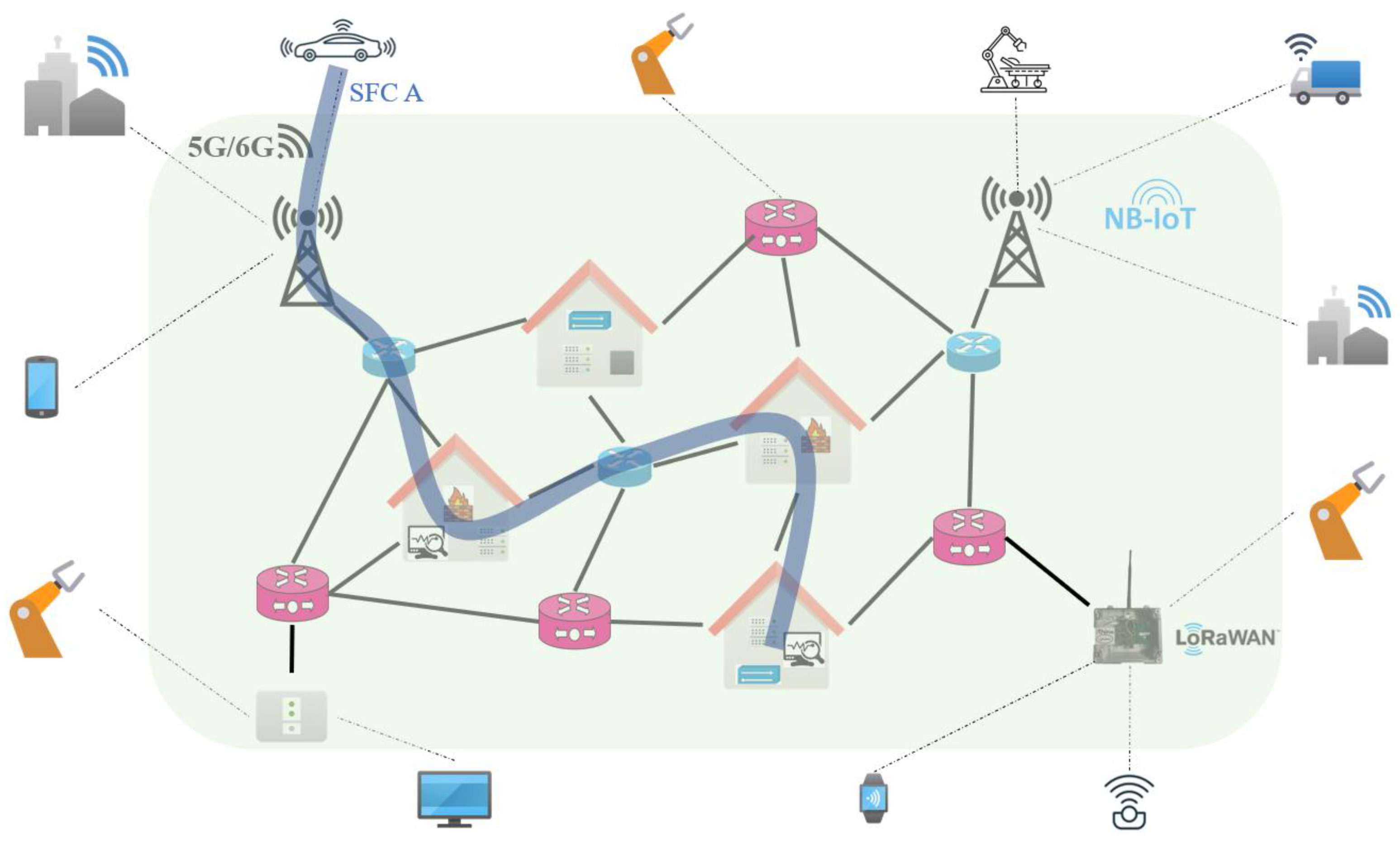





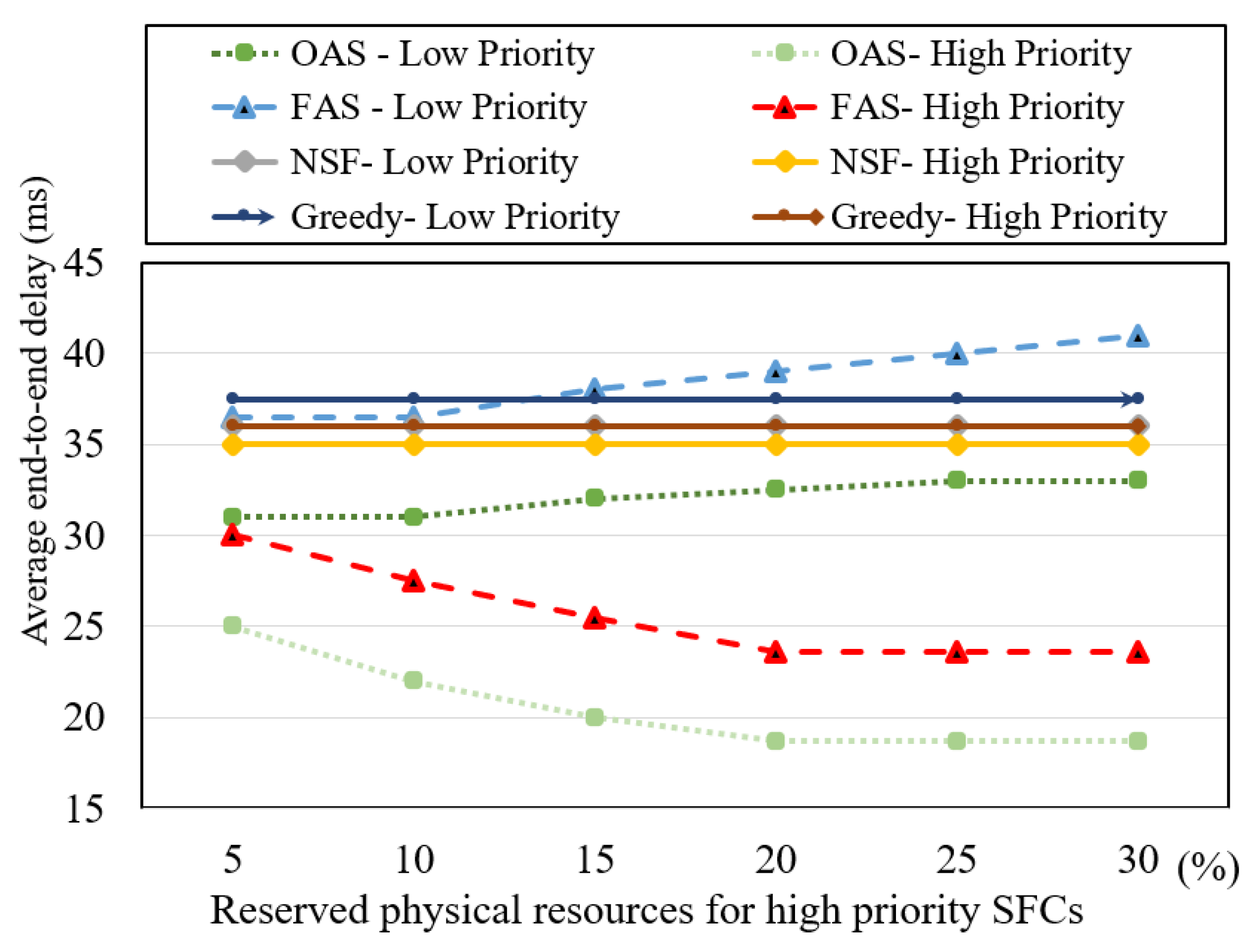

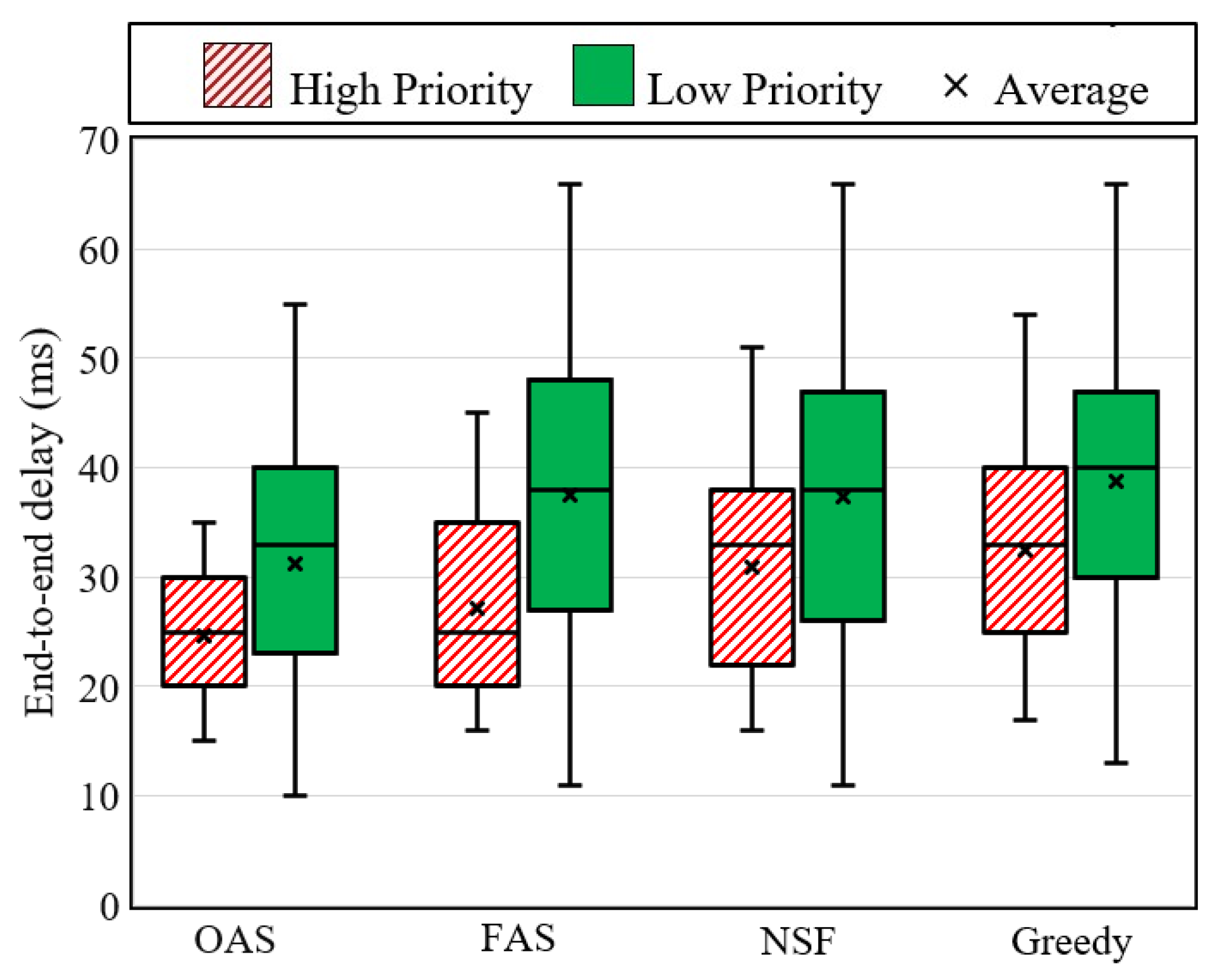
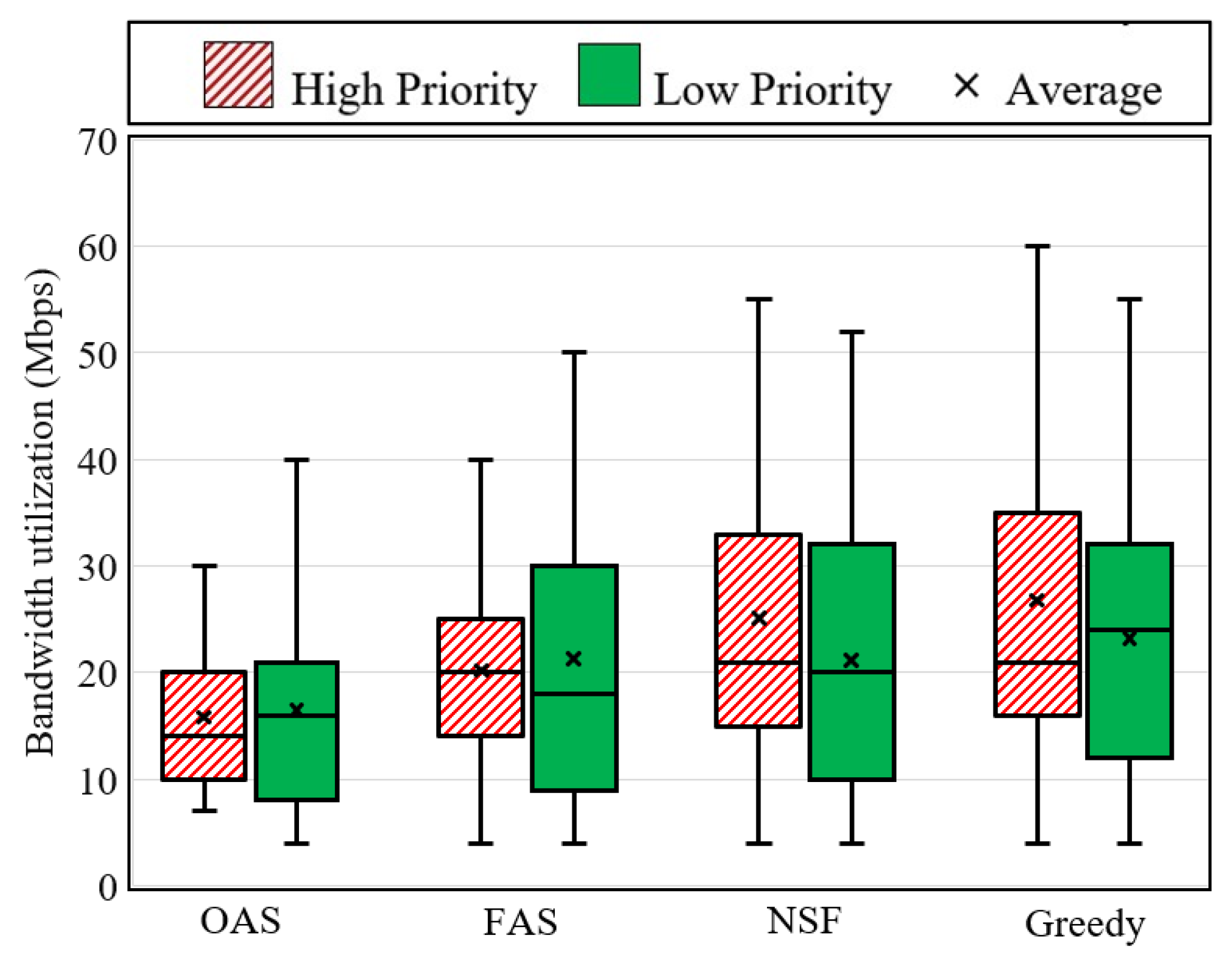
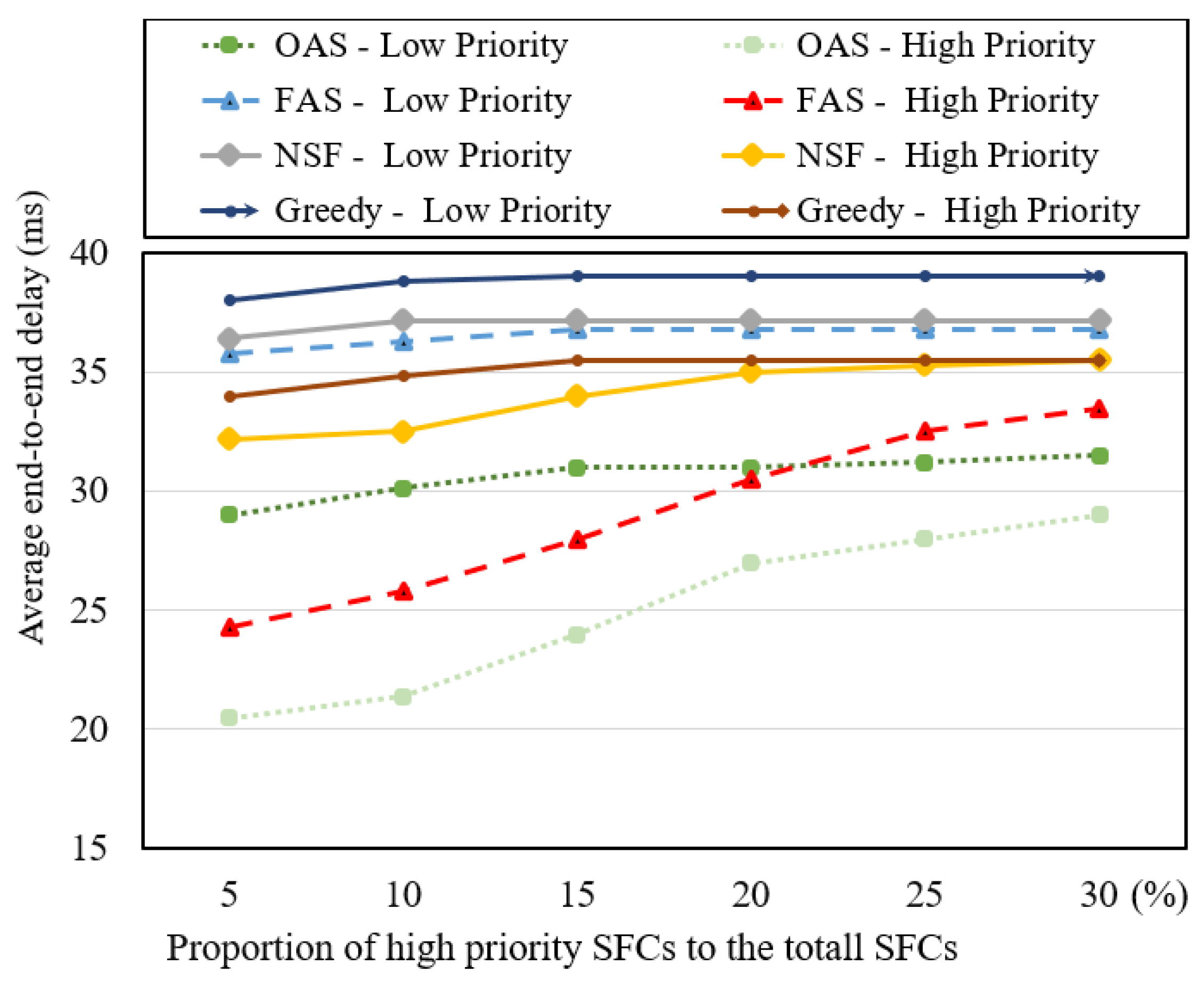


| Symbols | Description |
|---|---|
| The physical network | |
| The set of physical nodes | |
| The set of physical links | |
| The set of switching nodes () | |
| The set of CDC nodes ) | |
| F | The total number of SFC requests (flows) |
| F′ | The total number of low-priority SFC requests (flows) |
| X | The total number of VNF types (e.g., a, b, c, d, etc.) |
| The priority of SFC requests f | |
| The priority coefficient factor for physical resource reservation ( | |
| A binary variable, whether flow f traverses the link (m, n) or not | |
| A binary variable, whether flow f uses VNF type x, which is placed at CDC node m, or not | |
| The total bandwidth capacity of link (m, n) | |
| The total CPU capacity of node m | |
| The total memory capacity of node m | |
| The source node of SFC request f | |
| The destination node of SFC request f | |
| The matrix of required VNFs by SFC request f | |
| The matrix of ordering of VNFs requested by SFC request f | |
| The required bandwidth by SFC request f | |
| The required CPU by SFC request f | |
| The required memory by SFC request f | |
| The maximum tolerated delay by SFC request f | |
| The propagation delay on link (m, n) | |
| The matrix represents the VNF types placed on each CDC node | |
| The matrix T represents the ordering-aware rerouting matrix | |
| Contains all required VNFs with a higher order (i.e., lower index) than |
Disclaimer/Publisher’s Note: The statements, opinions and data contained in all publications are solely those of the individual author(s) and contributor(s) and not of MDPI and/or the editor(s). MDPI and/or the editor(s) disclaim responsibility for any injury to people or property resulting from any ideas, methods, instructions or products referred to in the content. |
© 2023 by the authors. Licensee MDPI, Basel, Switzerland. This article is an open access article distributed under the terms and conditions of the Creative Commons Attribution (CC BY) license (https://creativecommons.org/licenses/by/4.0/).
Share and Cite
Erbati, M.M.; Tajiki, M.M.; Schiele, G. Service Function Chaining to Support Ultra-Low Latency Communication in NFV. Electronics 2023, 12, 3843. https://doi.org/10.3390/electronics12183843
Erbati MM, Tajiki MM, Schiele G. Service Function Chaining to Support Ultra-Low Latency Communication in NFV. Electronics. 2023; 12(18):3843. https://doi.org/10.3390/electronics12183843
Chicago/Turabian StyleErbati, Mohammad Mohammadi, Mohammad Mahdi Tajiki, and Gregor Schiele. 2023. "Service Function Chaining to Support Ultra-Low Latency Communication in NFV" Electronics 12, no. 18: 3843. https://doi.org/10.3390/electronics12183843
APA StyleErbati, M. M., Tajiki, M. M., & Schiele, G. (2023). Service Function Chaining to Support Ultra-Low Latency Communication in NFV. Electronics, 12(18), 3843. https://doi.org/10.3390/electronics12183843












